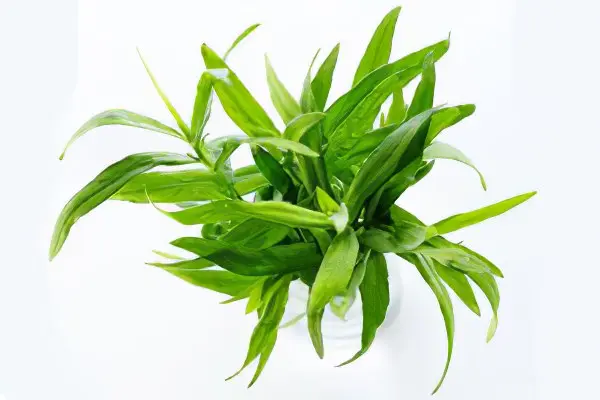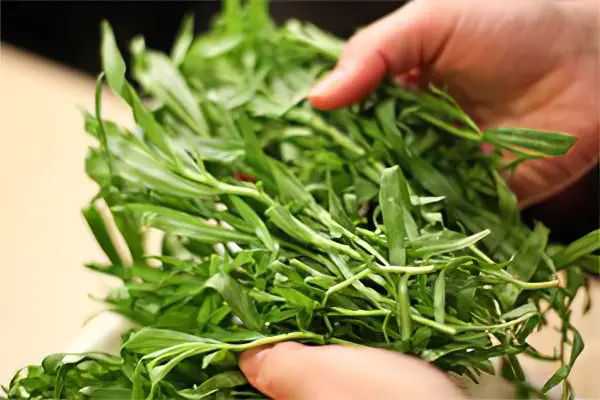Contents

Tarragon is a perennial plant, its appearance is a bit like wormwood. This plant grows in a bush, it can reach a height of 1,5 m. Tarragon leaves are dark green in color, rather narrow in shape, have a strong but pleasant aroma, taste a bit like pineapple. The stems have a yellowish-brown color, many branches depart from them. Leaves up to 80 mm long and up to 10 mm wide, green with a glossy sheen. Tarragon blooms in the second half of summer, the flowers are small, mostly yellow. Tarragon is also called tarragon or tarragon tarragon. Tarragon bears fruit with an achene that does not have a tuft. The fruits appear in October.
Tarragon leaves are widely used in cooking, for example, a variety of salads, as well as in pickling vegetables and sauerkraut. Tarragon begins to grow in early spring – almost immediately, as soon as the snow melts. Tarragon is most useful in the first three years of growth, despite the fact that it may well grow in a new place up to 10 years.
The plant is cultivated everywhere, although in many countries, including Russia, it grows wild. Prefers pebbly and dry steppe slopes, although it can also be found in fields.
It is believed that the plant was brought to European countries from Siberia and Mongolia, which happened during the invasion of the Tatar-Mongol yoke. The most common varieties of tarragon are French, Russian and Transcaucasian tarragon.
Composition and calorie content
Calories 24,8 KKal
- Fats:
0,8 g
- Proteins:
1,5 g
- Carbohydrates:
5,0 g
- Water:
91,7 g
- Ash:
1,0 g
- Cellulose:
0,5 g
Vitamins | Quantity | % RDN |
Vitamin K | 240 mcg | 200% |
Vitamin B6 (pyridoxine) | 0,29 mg | 15% |
Vitamin C (ascorbic acid) | 10 mg | 14% |
Minerals (in 100 g): | Quantity | %RDN |
Manganese | 960,2 mcg | 48% |
Vanadium | 12,7 mcg | 32% |
potassium | 260 mg | 9% |
Full chemical composition ➤
Other important connections:
Phytosterols — 9,8 mg (17,8% of RDI)
Purine — 6 mg (5% of RDI)
Oxalic acid — 5,2 mg (1,3% of RDI)
Useful properties of tarragon
Tarragon, as you know, is valued not only for its spicy taste, but also for a fairly high content of carotene and vitamin C. Like many other leaf spices, fragrant tarragon is able to give a person vigor. Tarragon essential oil has its own unique smell, characteristic only for this plant. It is precisely these properties of tarragon essential oil that create this unique aroma and pleasant spicy taste with a slight bitterness. Tarragon essential oil contains phellandrene, sabinene and ocimene.
In folk medicine, tarragon is popular as a diuretic, and its good antiscorbutic effect is also noted, in addition, it can simply be used as a general tonic. This wonderful plant is distinguished not by its pungency, but by the high aroma of essential oil, which is used in perfumery. Tarragon is able to improve appetite, also stimulate digestion, it is used for dropsy, as a diuretic. Also, the plant can have a calming effect, improve sleep. In the treatment of tuberculosis, pneumonia and bronchitis in Tibetan medicine, tarragon was used as a medicine.
The use of tarragon in food is useful for the prevention of heart attack and stroke, since the compounds contained in its composition prevent the formation of blood clots.
Depending on the purpose for which tarragon is used, the following effects can be achieved:
Calming effect (normalizes sleep, helps to cope with depression);
Wound healing effect (strengthens the walls of blood vessels, ensures their elasticity);
Removal of inflammation;
Tonic effect;
Strengthening the body (increases immunity);
Removal of spasm (relaxes nerves, relieves toothache);
Getting rid of parasites;
Diuretic effect (helps eliminate edema, removes excess fluid from the body);
Wind effect.
Thanks to tarragon, you can lower blood pressure, normalize the metabolic process, strengthen the walls of blood vessels, and improve digestion. When the herb is used in food, there is an increase in the production of gastric juice, and appetite improves.
Another well-known property of tarragon is its effect on the sex glands. In particular, in men, the intake of tarragon in food increases potency.
The use of tarragon

Since ancient times, tarragon (tarragon) has been successfully used in the fight against headaches and toothaches, as well as insomnia, depression, and poor appetite. Tarragon is advised to be taken after a heavy meal in order to improve the digestive process, and this miracle plant is also recommended for increasing potency in men. The latter is explained only by the fact that tarragon has a general strengthening effect on the body. Tarragon, when combined with other herbs, can be used as a salt substitute, which is extremely convenient for people suffering from hypertension.
Tarragon is used for treatment in a dried state, in the form of medicinal tinctures and teas. A decoction is prepared from the leaves of the plant, which earlier, and even now, many people use for various diseases of the gastrointestinal tract, as well as intestinal cramps, sluggish digestion, flatulence, hiccups, painful periods in women, menstrual irregularities and premenstrual syndrome.
A decoction prepared from tarragon roots is good for toothaches. Preparations made from tarragon have wound healing, anti-inflammatory, antispasmodic, carminative, diuretic, sedative and antihelminthic properties. Tarragon has a tonic effect, calms the nervous system.
The use of tarragon in cooking
The use of tarragon in cooking is widespread. The plant is used as a spice that adds flavor to the dish and enhances its taste. It is added during conservation, during sauerkraut, when soaking pears and apples.
Tarragon is used in the preparation of hot dishes: meat, mushroom, fish. Tarragon is often added to alcoholic beverages, such as liquor, vodka, wine, which makes their taste and aroma more piquant.
Food can not only change its taste and aroma if tarragon is added to it, but it will also be stored longer, since this plant acts as a natural preservative.
The use of tarragon in cooking is especially common in France, where the herb is part of the famous Béarnaise sauce.
Russia, Georgia, Armenia, Kazakhstan, Ukraine – the inhabitants of all these countries are familiar with the taste of a soft drink called Tarragon, in which tarragon is used as the main flavor.
Tea is brewed with tarragon, which will be especially useful for people suffering from insomnia.
Tarragon drink at home
It is not difficult to prepare a drink from tarragon at home. To do this, you need to take 100 g of grass, one lemon, one lime, mint, sugar and water.
First, the tarragon is thoroughly washed, then all the leaves must be cut off from the stem and chopped, tearing them with your hands. The stems should be cut with a knife into small pieces, about 10 mm long. Boil water and pour chopped stems and sugar (50 g) into it, leaving it on fire for 5 minutes, then remove from the stove. Water for this amount of sugar will require 250 ml.
Torn leaves are mixed with citrus juice and poured into prepared sugar syrup. This must be done before it cools down. Then the container with all the contents is covered with a lid and allowed to brew for an hour. The finished infusion is filtered and adjusted to the desired concentration with sparkling water or still water. You can decorate such homemade lemonade with a slice of lemon and tarragon leaves.
Противопоказания
Contraindications of tarragon are due to the poison included in its composition. Do not forget that the plant belongs to the Wormwood genus, which means that it must be used very carefully. If tarragon is used as a medicinal product, then it is strictly forbidden to exceed the recommended dose. This threatens with serious poisoning, the development of convulsions, loss of consciousness.
Tarragon is contraindicated in diseases of the gastrointestinal tract (peptic ulcer, gastritis with high acidity), it should not be eaten during gestation, during breastfeeding, in the presence of individual intolerance.
In addition, there is evidence that prolonged use of tarragon in food can provoke the development of cancerous tumors, since it contains a substance such as methylchavicol. But in this case we are talking about the regular consumption of grass in large quantities. As a spice used in cooking, tarragon does not pose a risk to human health if it does not have the above contraindications.









